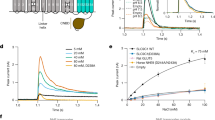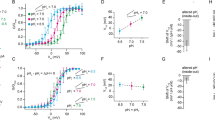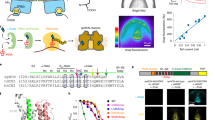Abstract
Changes in membrane potential affect ion channels and transporters, which then alter intracellular chemical conditions. Other signalling pathways coupled to membrane potential have been suggested1,2,3 but their underlying mechanisms are unknown. Here we describe a novel protein from the ascidian Ciona intestinalis that has a transmembrane voltage-sensing domain homologous to the S1–S4 segments of voltage-gated channels and a cytoplasmic domain similar to phosphatase and tensin homologue. This protein, named C. intestinalis voltage-sensor-containing phosphatase (Ci-VSP), displays channel-like ‘gating’ currents and directly translates changes in membrane potential into the turnover of phosphoinositides. The activity of the phosphoinositide phosphatase in Ci-VSP is tuned within a physiological range of membrane potential. Immunocytochemical studies show that Ci-VSP is expressed in Ciona sperm tail membranes, indicating a possible role in sperm function or morphology. Our data demonstrate that voltage sensing can function beyond channel proteins and thus more ubiquitously than previously realized.
This is a preview of subscription content, access via your institution
Access options
Subscribe to this journal
Receive 51 print issues and online access
$199.00 per year
only $3.90 per issue
Buy this article
- Purchase on Springer Link
- Instant access to full article PDF
Prices may be subject to local taxes which are calculated during checkout




Similar content being viewed by others
References
Zhang, C. & Zhou, Z. Ca2+-independent but voltage-dependent secretion in mammalian dorsal root ganglion neurons. Nature Neurosci. 5, 425–430 (2002)
Zhang, C. et al. Calcium- and dynamin-independent endocytosis in dorsal root ganglion neurons. Neuron 42, 225–236 (2004)
Schultz, J. E., Klumpp, S., Benz, R., Schurhoff-Goeters, W. J. & Schmid, A. Regulation of adenylyl cyclase from Paramecium by an intrinsic potassium conductance. Science 255, 600–603 (1992)
Hirokawa, T., Boon-Chieng, S. & Mitaku, S. SOSUI: classification and secondary structure prediction system for membrane proteins. Bioinformatics 14, 378–379 (1998)
Lee, J. O. et al. Crystal structure of the PTEN tumor suppressor: implications for its phosphoinositide phosphatase activity and membrane association. Cell 99, 323–334 (1999)
Maehama, T., Taylor, G. S. & Dixon, J. E. PTEN and myotubularin: novel phosphoinositide phosphatases. Annu. Rev. Biochem. 70, 247–279 (2001)
Bezanilla, F. Voltage sensor movements. J. Gen. Physiol. 120, 465–473 (2002)
Bezanilla, F., Perozo, E., Papazian, D. M. & Stefani, E. Molecular basis of gating charge immobilization in Shaker potassium channels. Science 254, 679–683 (1991)
Maehama, T. & Dixon, J. E. The tumor suppressor, PTEN/MMAC1, dephosphorylates the lipid second messenger, phosphatidylinositol 3,4,5-trisphosphate. J. Biol. Chem. 273, 13375–13378 (1998)
Taylor, G. S. & Dixon, J. E. PTEN and myotubularins: families of phosphoinositide phosphatases. Methods Enzymol. 366, 43–56 (2003)
Maehama, T., Taylor, G. S., Slama, J. T. & Dixon, J. E. A sensitive assay for phosphoinositide phosphatases. Anal. Biochem. 279, 248–250 (2000)
Huang, C. L., Feng, S. & Hilgemann, D. W. Direct activation of inward rectifier potassium channels by PIP2 and its stabilization by Gβγ. Nature 391, 803–806 (1998)
Zhang, H. et al. PIP2 activates KCNQ channels, and its hydrolysis underlies receptor-mediated inhibition of M currents. Neuron 37, 963–975 (2003)
Zhang, H., He, C., Yan, X., Mirshahi, T. & Logothetis, D. E. Activation of inwardly rectifying K+ channels by distinct PtdIns(4,5)P2 interactions. Nature Cell Biol. 1, 183–188 (1999)
Rohacs, T., Chen, J., Prestwich, G. D. & Logothetis, D. E. Distinct specificities of inwardly rectifying K+ channels for phosphoinositides. J. Biol. Chem. 274, 36065–36072 (1999)
Horn, R. Coupled movements in voltage-gated ion channels. J. Gen. Physiol. 120, 449–453 (2002)
Bezanilla, F. The voltage sensor in voltage-dependent ion channels. Physiol. Rev. 80, 555–592 (2000)
Campbell, R. B., Liu, F. & Ross, A. H. Allosteric activation of PTEN phosphatase by phosphatidylinositol 4,5-bisphosphate. J. Biol. Chem. 278, 33617–33620 (2003)
Iijima, M., Huang, Y. E., Luo, H. R., Vazquez, F. & Devreotes, P. N. Novel mechanism of PTEN regulation by its phosphatidylinositol 4,5-bisphosphate binding motif is critical for chemotaxis. J. Biol. Chem. 279, 16606–16613 (2004)
Izumi, H., Marian, T., Inaba, K., Oka, Y. & Morisawa, M. Membrane hyperpolarization by sperm-activating and -attracting factor increases cAMP level and activates sperm motility in the ascidian Ciona intestinalis. Dev. Biol. 213, 246–256 (1999)
Yoshida, M., Murata, M., Inaba, K. & Morisawa, M. A chemoattractant for ascidian spermatozoa is a sulfated steroid. Proc. Natl Acad. Sci. USA 99, 14831–14836 (2002)
Walker, S. M., Downes, C. P. & Leslie, N. R. TPIP: a novel phosphoinositide 3-phosphatase. Biochem. J. 360, 277–283 (2001)
Tapparel, C. et al. The TPTE gene family: cellular expression, subcellular localization and alternative splicing. Gene 323, 189–199 (2003)
Reymond, A. et al. Human chromosome 21 gene expression atlas in the mouse. Nature 420, 582–586 (2002)
Dong, X. Y. et al. Identification of two novel CT antigens and their capacity to elicit antibody response in hepatocellular carcinoma patients. Br. J. Cancer 89, 291–297 (2003)
Dehal, P. et al. The draft genome of Ciona intestinalis: insights into chordate and vertebrate origins. Science 298, 2157–2167 (2002)
Goldin, A. L. Maintenance of Xenopus laevis and oocyte injection. Methods Enzymol. 207, 266–279 (1992)
Taglialatela, M., Toro, L. & Stefani, E. Novel voltage clamp to record small, fast currents from ion channels expressed in Xenopus oocytes. Biophys. J. 61, 78–82 (1992)
Padma, P. et al. Identification of a novel leucine-rich repeat protein as a component of flagellar radial spoke in the ascidian Ciona intestinalis. Mol. Biol. Cell 14, 774–785 (2003)
Acknowledgements
We thank D. E. Logothetis for providing IRK1 R228Q plasmid, Y. Kubo for providing wild-type IRK1 plasmid, T. Nukada for G-protein β1 and γ1 subunit plasmids, D. McKinnon and K. Nakajo for KCNQ2/3 plasmids, M. Lazdunski for GIRK2 plasmid, T. Maehama for advice on measuring phosphatase activity, F. Kukita for help in cut-open oocyte recording, J. Cui for discussion, N. Satoh and Y. Satou for help in bioinformatics, and D. McLean for critical reading of the manuscript. This work was supported by Research Fellowships of the Japan Society for the Promotion of Science for Young Scientists to Y.M., Grants-in-Aid for Scientific Research to Y.O. and H.I., and a Grant-in-Aid for Creative Scientific Research from the Ministry of Education, Culture, Sports, Science and Technology to Y.O.
Author information
Authors and Affiliations
Corresponding author
Ethics declarations
Competing interests
The full-length cDNA sequence of Ci-VSP is deposited in the DNA Data Bank of Japan (DDBJ) under the accession number AB183035. Reprints and permissions information is available at npg.nature.com/reprintsandpermissions. The authors declare no competing financial interests.
Supplementary information
Supplementary Figure S1
This figure illustrates coupling of voltage sensor and phosphatase revealed by mutated IRK1 channel and KCNQ2/3 channel. (DOC 180 kb)
Supplementary Figure S2
This illustrates effect of deletion of a linker region between voltage sensor and phosphatase domain of Ci-VSP. (DOC 142 kb)
Supplementary Figure S3
This illustrates specificity of antibodies for Ci-VSP. (DOC 231 kb)
Supplementary Method
This describes cloning of Ci-VSP cDNA, mutagenesis of Ci-VSP cDNA, Q-V plot of asymmetrical charge movements, biotinylation labeling of Ci-VSP protein in Xenopus oocyte, imunoblot analysis, in vitro phosphatase assay, RT-PCR detection of Ci-VSP transcript in Ciona intestinalis, and immunoelectron microscopy. (DOC 59 kb)
Rights and permissions
About this article
Cite this article
Murata, Y., Iwasaki, H., Sasaki, M. et al. Phosphoinositide phosphatase activity coupled to an intrinsic voltage sensor. Nature 435, 1239–1243 (2005). https://doi.org/10.1038/nature03650
Received:
Accepted:
Published:
Issue Date:
DOI: https://doi.org/10.1038/nature03650
This article is cited by
-
Ion currents through the voltage sensor domain of distinct families of proteins
Journal of Biological Physics (2023)
-
Voltage imaging in the olfactory bulb using transgenic mouse lines expressing the genetically encoded voltage indicator ArcLight
Scientific Reports (2022)
-
Multiple mechanisms contribute to fluorometry signals from the voltage-gated proton channel
Communications Biology (2022)
-
Voltage-sensing phosphatase (Vsp) regulates endocytosis-dependent nutrient absorption in chordate enterocytes
Communications Biology (2022)
-
Structural mechanism of TRPM7 channel regulation by intracellular magnesium
Cellular and Molecular Life Sciences (2022)
Comments
By submitting a comment you agree to abide by our Terms and Community Guidelines. If you find something abusive or that does not comply with our terms or guidelines please flag it as inappropriate.



